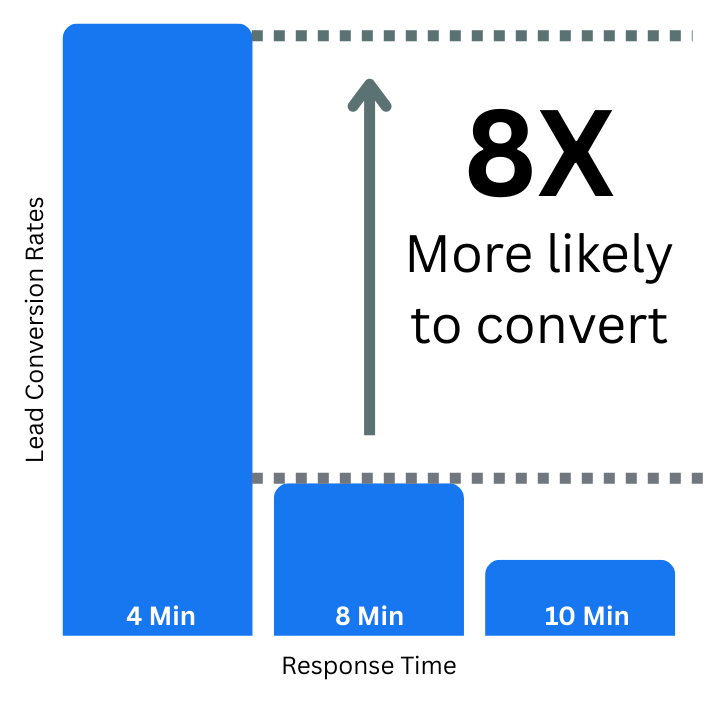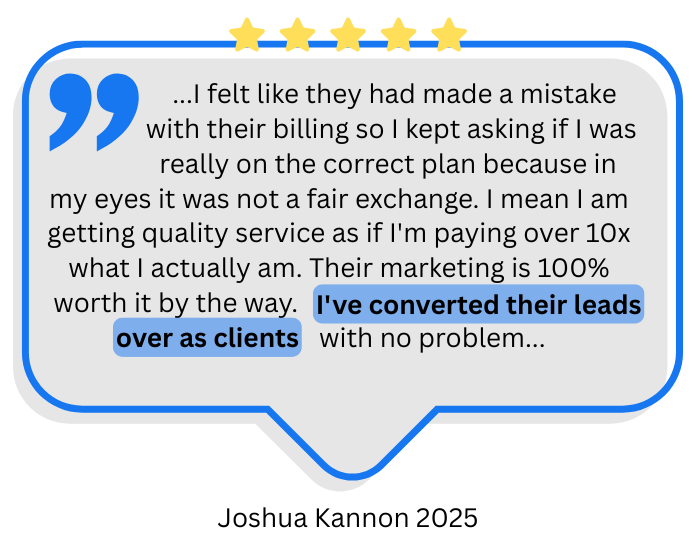Convert More Leads in the First 5 Minutes
The system built to stop slow follow-up from killing your close rate—step by step.


Step 1: Respond in 5 Minutes or Less
Because if you wait, you lose.
Leads contacted within 5 minutes are 8x more likely to convert.
After 10 minutes, you’ve already lost the sale.
Most businesses don’t follow up fast enough.
Not because they don’t care.
But because they don’t have a system.
They rely on memory. Or a calendar. Or a sales rep who’s “working through the list.”
Here’s what happens while you wait:
- The lead forgets who you are
- Clicks on someone else’s ad
- Books with a competitor
The problem isn’t your product.
It’s the delay. And if you don’t fix it, every lead you paid for gets weaker by the minute.
Fix it like this:
- Set up an SMS or email that fires immediately after a form is filled
- Use plain language—not corporate fluff
- Send from a real name, not a “noreply” inbox
- Keep it short: confirm, contextualize, invite next step
This one step alone can double your close rate—without touching your ad budget.
Don’t try to automate everything at once.
Start with the lead source that matters most.
Set the message. Test it. Make it hit fast.
The difference between 5 minutes and 15?
It’s not a gap in time—it’s a gap in revenue.
Step 2: Follow Up Like You Mean It
Because no response doesn’t mean no interest.
60% of leads won’t reply to your first message.
But most businesses never send a second.
Here’s what most teams do:
– Send one message
– Don’t hear back
– Move on
That’s not a follow-up strategy.
That’s giving up early and calling it efficiency.
The truth?
Most leads don’t respond because of timing, not disinterest.
They’re busy. Distracted. Unclear.
And unless you stay present, someone else earns the sale.
Here’s what follow-up should actually look like:
- Day 0: Instant confirmation (sets context)
- Day 2: Friendly check-in (low pressure)
- Day 4: Reframe the value (new angle)
- Day 7: Ask directly if they’re still interested
- Day 10+: Final message or closeout
This isn’t “drip marketing.”
It’s guided decision-making.
And when done right, it builds trust—not tension.
How to set it up:
- Write 5 messages max
- Make each one useful, short, and human
- Automate the timing inside your system so no one slips through
- Use replies to learn what’s working—then improve it
If you don’t have a follow-up system, you’re just hoping.
Hope doesn’t scale. Follow-up does.
Step 3: Say What Actually Converts
Because most messages don’t get ignored—they get deleted.
Your timing might be perfect.
But if your message sounds like everyone else, the lead tunes out instantly.
Most reps don’t lose leads because they said the wrong thing.
They lose them because they said something forgettable.
Safe. Generic. Too long. Too vague.
Here’s what happens:
– The lead opens the message
– Scans the first sentence
– Can’t tell if it’s helpful
– Closes the tab
– Doesn’t come back
That’s not a conversion problem.
That’s a messaging problem.
Here’s what high-converting teams do:
- Write messages like real humans—not templates
- Use short, specific sentences with one clear goal
- Start with context: remind them who you are and why you’re reaching out
- End with direction: reply, schedule, confirm, etc.
Don’t write to explain.
Write to convert.
What to improve right now:
- Look at the first follow-up message you send
- Cut the fluff. Keep the value. Make it sound like you
- Test different versions—track what gets replies
- If you’re not sure what to say, ask us. We’ll help you tighten it.
The message is the moment.
If it doesn’t land, nothing else will.
Step 4: Separate Buyers from Time-Wasters
Because not every lead deserves your time—or your team’s.
If you treat every lead the same, you’re wasting time, energy, and attention on people who were never going to buy.
Most businesses don’t have a lead problem.
They have a filtering problem.
Their CRM looks full.
But 40% of those leads are junk.
Wrong market. Wrong mindset. Wrong info.
If your team can’t tell the difference, your follow-up gets slower, more frustrating, and less effective.
Here’s the fix:
You tag every lead as soon as they come in:
- Good leads: Filled out the full form, in your region, know what they’re looking for
- Bad leads: Missing info, out of area, no reply, or clearly confused about why you contacted them
Tag them. All of them.
And don’t wait.
The system only gets smarter if you feed it honest feedback.
This isn’t just about organization.
This is about speed, accuracy, and scale.
When you tag right, the system learns what a real lead looks like—and filters accordingly.
What to do right now:
- Update your lead intake to include location + form completion checks
- Tag every lead “good” or “bad” based on behavior, not assumptions
- Review patterns weekly to adjust your filters + targeting
This takes 10 seconds per lead.
But it saves hours. And it makes your system better every time it runs.
Step 5: Make Every Sale Worth More
Because closing the deal is just the start.
Most teams stop tracking at the close.
But the most profitable ones? They start there.
Here’s what most businesses miss:
You fight hard to win a lead.
Then you close them.
And… that’s it.
No review. No referral. No system for tracking how valuable the deal actually was.
That’s not growth. That’s a revolving door.
Here’s what top teams do after every sale:
- Log how much the customer is worth over the next 12 months (LTV)
- Trigger a review request while the experience is fresh
- Prompt a referral while satisfaction is high
This doesn’t take more time.
It just takes consistency.
If you’re not logging value, you’re not building anything.
You’re just checking boxes.
Every LTV entry teaches the system what a good lead is worth.
Every review builds trust for the next buyer.
Every referral reduces your cost per sale.
Set it up like this:
- After each closed deal, enter their 12-month value in Ratesight
- Use the built-in review flow (don’t ask manually—automate it)
- Include a referral line in your post-sale message: “Who else should we help?”
You already did the hard part.
Now let each win create momentum for the next one.
What Other Businesses Are Saying:


Step 6: Use Your Customer List to Attract Better Leads
Because your best leads already bought—use them to find the next ones.
Platforms guess who might buy.
You already know who did.
Most businesses keep running cold traffic ads, chasing new leads from scratch.
But your most valuable targeting data isn’t on Meta or Google.
It’s in your CRM.
Your customer list is the proof.
It tells the system exactly who buys, how much they’re worth, and what they have in common.
Here’s what to upload:
- First Name
- Last Name
- Phone
- 12-Month Value (LTV)
That’s it.
Upload that into Ratesight—and let the system go to work.
This isn’t “lookalike audience” targeting.
This is training the system to prioritize based on reality.
You’re not guessing who to talk to next.
You’re showing the system who’s already said yes—and telling it to find more of them.
How to use it:
- Export your top clients with accurate LTVs
- Upload them to Ratesight’s backend
- Use that data to inform outreach, retargeting, and lead scoring
This is how pros scale.
Not by doing more—but by doubling down on what’s already proven to work.
Before You Add More Leads—Fix the Way You Handle the Ones You’ve Got
Because scaling a broken system just gets you more of what’s not working.
More leads help—but only if your system is built to convert them.
Here’s how the best teams increase close rates without increasing ad spend:
- They respond within 5 minutes—so the lead never goes cold
- They follow up with structure—not one-off check-ins
- They use messaging that gets replies—not generic scripts
- They tag leads so the system knows who to prioritize
- They track actual deal value—not just status updates
- They build trust with reviews, and growth with referrals
- They use real customer data to target better prospects
Before you spend more to get more—tighten the system behind what you already have.
New to Ratesight?
Start a free trial and put this system to work.
It’s not more effort. It’s just better follow-through.